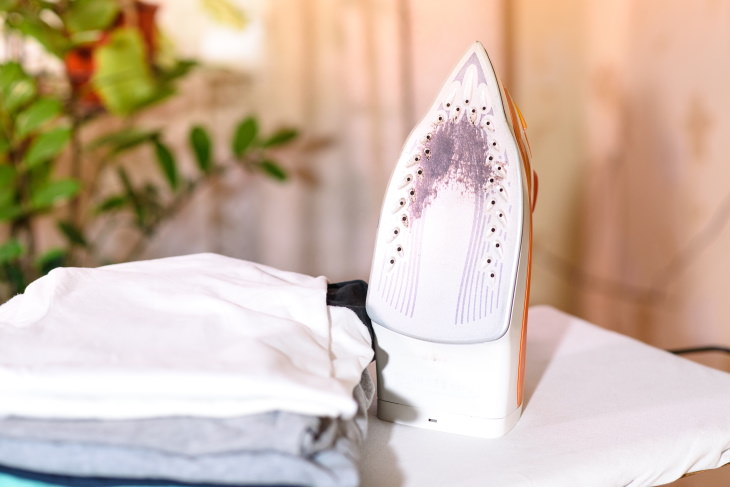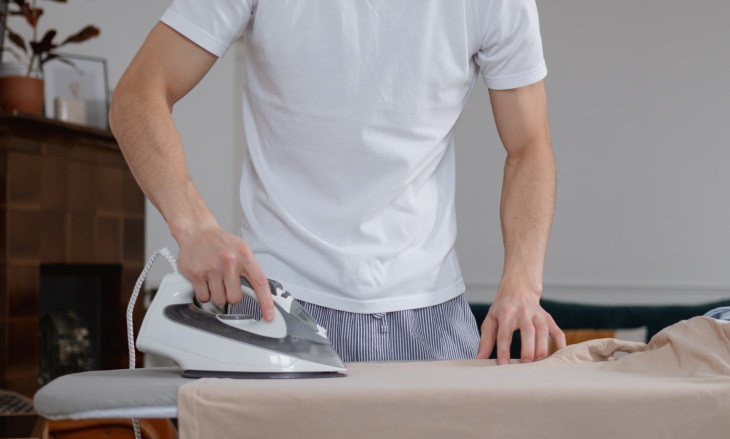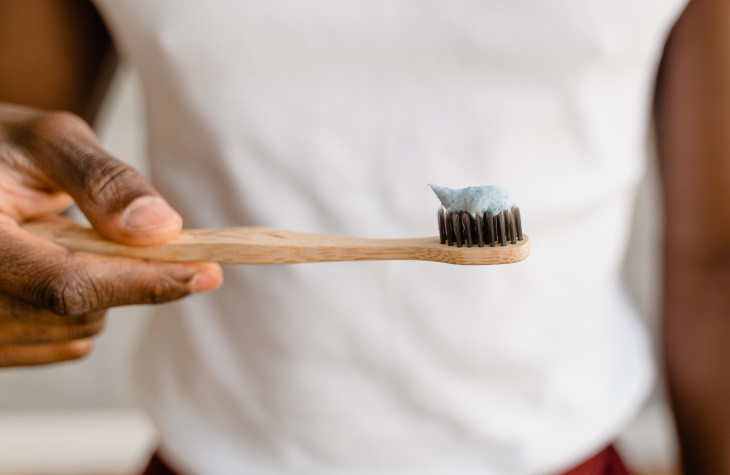

Since most modern irons have a steam function and require that you feed water into them to work, irons can get dirty both on the outside and on the inside. In the first scenario, it’s pretty clear when your iron requires a bit of scrubbing. Gunk from starches, leftover detergent, or hard water residue can build up at the bottom of the iron or inside the steam holes, for example, and this could damage or stain your clothing. This buildup is visible to the eye - just flip the iron, and you’ll see white, yellow, or even brown buildup on the metal plate.
However, another common issue with steam irons is limescale buildup, and this can be a bit trickier to spot. Pay closer attention to your iron and look out for these signs. They indicate that your iron could use some descaling:
- The iron leaves streaks or stains
- Chalky white or yellow flakes on freshly ironed clothes
- Unpleasant smells
- The clothes feel sticky after ironing (especially on the hottest setting).
If you experience any of these problems while ironing or just notice that the iron doesn’t work as well as it once did, consider deep cleaning your iron. Otherwise, your iron may damage your clothing, break faster than it should, or even cause an electric fire.
Most people will only need to clean their irons once a year, but others may need to do so more often. It’s especially helpful to clean your iron regularly if you live in an area with hard water. Below, we list 6 simple tricks that will clean your iron both inside and out.

Soleplate buildup is a common issue, and using salt and newspaper is one of the simplest ways to remove it without any vigorous scrubbing. Before you dismiss this idea as crazy, hear us out. The salt crystals work like abrasive sandpaper and scrub away the gunk from the metal coating of your iron. Here’s how:
1. Set the iron to the highest temperature.
2. Place a newspaper on the ironing board and sprinkle plenty of salt on the newspaper. Don't have a newspaper on hand? Brown paper bags work great for this trick as well.
3. When the iron gets hot, move it over the salted paper in circular motions.
4. Unplug the iron and let the plates cool completely.
5. Dampen a soft cloth and wipe down any dirt remnants and salt from the iron.
Before you try this trick, read the manufacturer’s instructions regarding the use of abrasive cleaners. Some irons have a nonstick coating that could be damaged by anything scratchy. But don’t worry, we’ll show you a method that works for soleplate buildup for irons with nonstick coating next.
Related Article: Ironing Alternatives - 9 Hacks to Unwrinkle Your Clothes

Do you have a bottle of white vinegar in your kitchen cupboard? If so, you can clean your iron inside and out right now. We know that vinegar has countless handy uses, but few people are aware that it can also be used to clean your entire steam iron in a matter of minutes - from rust and scorch marks to clogged steam holes.
- Unclog steam holes using vinegar
Unplug and work with a cold steam iron. Dip a cotton swab in vinegar and insert it in the steam holes, twirling it gently to loosen up the limescale. The vinegar is gently acidic and will help dissolve the hard water buildup.
- Remove rust staining with vinegar
Corrosion can make your iron leave rusty stains. To clear out the rust from the appliance, soak a clean towel in white vinegar and place the cold iron on the towel for 30 minutes. As the last step, wipe the plates clean, and you’re done. The towel will have absorbed any signs of corrosion from the metal plate.
- Get rid of scorch marks and buildup using vinegar
This method is pretty straightforward, but it works! Just saturate a clean cloth in some vinegar and rub the stained area until the buildup is gone. The iron should be cold. Keep moving the cloth to always use the clean part.
- Clean the water tank with vinegar
If you suspect that the water tank and the steam holes are covered in limescale, you can use a 1:1 water and vinegar mixture to get rid of it. Follow these steps:
1. Fill the water tank until it’s around a third full with half water and half vinegar, turn it on, and then use the iron to steam an old cloth. The vinegar will dissolve the hard water residue, and it will come out of the iron with the steam.
2. After 5-10 minutes of steaming, turn off the iron.
3. Refill the tank with plain water and turn it on again. Steam for a few more minutes to flush out traces of limescale and vinegar.
4. Let the iron cool completely and then clean the metal plate with a clean cloth.

Plastic buttons, zippers, and other details can melt in contact with high heat and could end up sticking to the iron. If this happens, you will, unfortunately, not be able to salvage the plastic detail, but you can still save the iron. Here’s how.
1. Unplug the iron immediately and let it cool down.
2. Fill a metal container with ice cubes and put the soleplate on the ice. The cold will harden the plastic.
3. Get a plastic knife and scrape off the stain. Don’t use any metal utensils, as these can damage the iron.
4. Clean the metal plate with a damp cloth.
Make sure to get off every piece of plastic. Even tiny plastic remnants will melt and can ruin the clothes you’ll be ironing next.

This is quite unexpected, but one of the most effective tricks for removing brown or black scorch marks from the bottom of the iron is using Tylenol. Well, it doesn’t have to be Tylenol specifically - any white pills with acetaminophen work just as well. Follow these steps to try this trick:
1. Crank up the heat to the highest temperature. Put on a pair of oven mitts to protect your fingers.
2. Once the iron is hot, rub the tablet onto the affected area. The tablet will melt into a gel, and this will dissolve the marks. You may need to use more than one tablet. Don’t use tweezers or any other metal tools, as these can scratch the iron.
3. Place a damp cloth on the ironing board. Move the iron in circular motions to remove any residue.

Toothpaste is a real multitasker too! It works great at removing residue from the metal part of the iron without being too abrasive. To remove scorch marks or any other residue from the bottom of the iron, dab a little toothpaste on a cotton swab and rub it over the affected area. It’s best to avoid steam holes when doing this. Finish by wiping off the toothpaste with a paper towel.
Related Article: 15 People Who Found Out the Hard Way That Irons Run Hot
Here’s one last trick for removing residue from the metal surface of an iron - grab some acetone! Simply saturate a cotton ball with some acetone nail polish remover. Wear oven mitts for this, as you’ll need to work with a hot iron, and preferably do this outside to avoid inhaling fume. Turn on the iron and swipe acetone onto the stain. The residue should be gone immediately. You can turn off the iron and let it cool down. As the last step, polish the iron with a damp cloth.

As with anything else, the best way to make sure that your iron serves you for years and years is by preventing any stains and buildup to begin with. To do so, follow these simple tips:
- Read labels before you decide to iron a garment. Not all clothing can be ironed. To prevent accidents, look at the laundry symbols on the garment’s care label. If you see a crossed-out iron symbol on the label, avoid ironing the item of clothing.
- Cover the garment with a press cloth or thin cotton cloth to create a barrier between the metal plate of the iron and the garment. It will serve as a buffer and prevent the garment from melting or scorching.
- Go as low as you can temperature-wise when ironing. This will protect both the iron itself and the garment from damage.
- Empty the water tank after every use to prevent limescale buildup.
- Use filtered water to fill up your iron if you live in an area of hard water.
Share these useful tips with others!